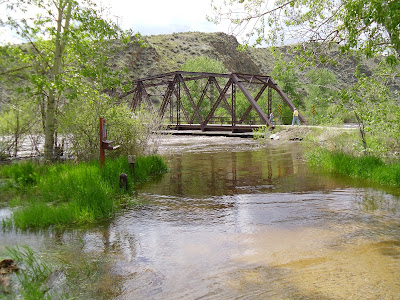 | |
| High water on Montana's Big Hole River. There is usually about 10 feet of clearance under this bridge. |
A couple weeks ago, when my son, Kevin, and I kept some North Dakota pike for dinner, we checked stomach contents to see what the fish had been eating. One pike had inch-long fish in its belly. That was no surprise, as pike love to eat other fish. Another fish, however, had white stringy-looking aquatic worms of some kind in its stomach. There have been other times when we’ve caught pike full of crayfish. We’ve also caught pike with bellies full of scuds, or what many think of as freshwater shrimp.
All of which demonstrates that northern pike are opportunistic feeders and there isn’t much in a pike’s neighborhood that they won’t eat, including baby muskrats and ducklings.
I seldom keep trout for dinner, so I usually don’t get that kind of information from trout I catch. Still, when I have a streamside chat with another angler it’s a good idea to pay attention when they provide post mortem information. A few weeks ago when camping on the Madison River, an angler from another campsite volunteered that he’d kept a couple fish, including a rainbow trout with a belly-full of salmonfly nymphs.
That was important news, a sign that salmon-flies, those stoneflies on steroids, were getting active in preparation for the annual transformation when Pteronarcys californica, or giant stonefly, leaves its home on the bottom of western rivers to crawl out of the water. Once out of the water, the insect climbs up streamside vegetation, such as willows or other brush, crawls out of its exoskeleton and emerge as a flying winged insect.
Fish feed on stonefly nymphs on a year-around basis, of course, as nymphs lose their grip on rocks and get picked off by alert fish. This time of year, however, those opportunities increase as nymphs migrate towards river shorelines, followed by trout in search of these big bites of protein.
The salmonfly emergence happens on many western rivers, though it’s not totally predictable just when those first nymphs will emerge from runoff-swollen rivers in search of a new identity and a literally once-in-a-lifetime opportunity to…shall we say, get lucky. Those female insects that don’t fall back into the river or get eaten by birds, and manage to mate, end their life cycle by flying back over the river to lay eggs along the water’s surface to start the next generation of giant stoneflies. It’s a cycle that has gone on for millions of years.
It’s an old tradition that on the Big Hole River, the salmonfly hatch begins on or about June 13, or Miners Union Day in Butte. On the other hand I’ve spotted adult salmon-flies on the Big Hole as early as Memorial Day and as late as the first week of July.
Just guessing, but this year the hatch will likely run late because of the cold spring we’ve had, as the hatch is triggered by a complex combination of water temperature and hours of daylight, or at least that’s how I understood the explanation that now-retired state fisheries biologist Dick Oswald gave me some years ago.
Another question is whether the Big Hole and other rivers with salmonfly hatches will be fishable when the big bugs emerge. Last week the amount of water rushing down the Big Hole River almost doubled to around 10,000 cubic feet per second as rains cut into the heavy mountain snowpack. There will, no doubt, be anglers out there floating the river during the high water, but for average boaters it’s downright dangerous in current conditions.
Still, the natural process continues and salmon-flies are emerging somewhere. In checking around I came across the website for Rock Creek Fisherman’s Mercantile, a flyshop near the mouth of Rock Creek. The shop reports the river is a roaring, chocolate torrent of water as it nears its confluence with the Clark Fork River. Still, salmon-flies were spotted on streamside bushes, preparing for the propagation of the species.
Life goes on, even if we’re not fishing.
